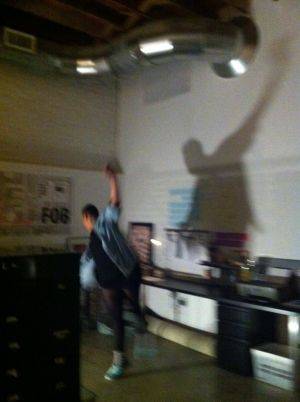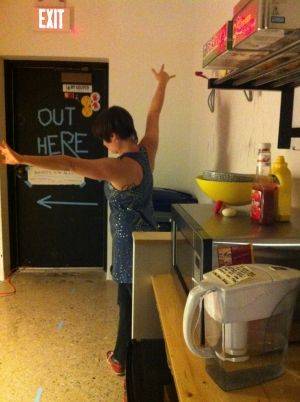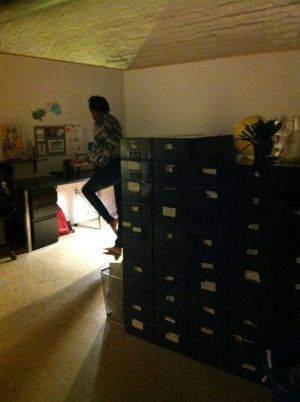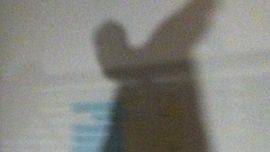 [co][lab] opened its door to MFA students in the dance department last Friday night. HOUSE SHOW SHIT SHOW // A SHOW, an installation using a non-conventional setting, used [co][lab]’s office space in order to redefine the boundaries and levels of interaction in a dance performance. Jessie Young, creator of the r e d o u b l e series, wanted the event to be not just a dance event, but an installation in which audience members could blur the line between audience members and performers. While there, I watched many audience members interact with dancers by entering performance spaces and dancing alongside artists. Audience members also took props from the dancers, gave props to dancers, and climbed ladders along with the dancers. [co][lab]’s office setting allowed dance to enter into the common world—as performers danced beside bottles of ketchup, microwaves, office desks, and bathrooms.
[co][lab] opened its door to MFA students in the dance department last Friday night. HOUSE SHOW SHIT SHOW // A SHOW, an installation using a non-conventional setting, used [co][lab]’s office space in order to redefine the boundaries and levels of interaction in a dance performance. Jessie Young, creator of the r e d o u b l e series, wanted the event to be not just a dance event, but an installation in which audience members could blur the line between audience members and performers. While there, I watched many audience members interact with dancers by entering performance spaces and dancing alongside artists. Audience members also took props from the dancers, gave props to dancers, and climbed ladders along with the dancers. [co][lab]’s office setting allowed dance to enter into the common world—as performers danced beside bottles of ketchup, microwaves, office desks, and bathrooms.
 Dance is often viewed as high culture, an art in which audience simply watch and do not ordinarily engage with performers. This installation challenged these preconceived notions. A night of interactive performances—artists dancing inparking lots, sitting on benches, lying in hallways, and moving alongside office desks—led me to reconsider what it means to be an audience member. Being so close to these performers made me appreciate the interactive aspect of art. I was able to hear a dancer’s feet shuffle across the floor. I had to (politely) step over a performer in order to use the restroom—an act so natural in such a tense, artistic setting.
Dance is often viewed as high culture, an art in which audience simply watch and do not ordinarily engage with performers. This installation challenged these preconceived notions. A night of interactive performances—artists dancing inparking lots, sitting on benches, lying in hallways, and moving alongside office desks—led me to reconsider what it means to be an audience member. Being so close to these performers made me appreciate the interactive aspect of art. I was able to hear a dancer’s feet shuffle across the floor. I had to (politely) step over a performer in order to use the restroom—an act so natural in such a tense, artistic setting.
On the technical side of things, darkness and light were also manipulated to enhance the experience. Being in an office at night might have seemed strange enough to the audience. Small lamps were placed on the floor, creating dramatic shadows across office walls. You could really watch the performer’s movement in an altogether new, indirect way.

Young, the night’s curator, would occasionally run throughout the building shouting “Hi!” at audience members and other performers. She would take a marker and write “hi” on the office whiteboard, which had not been erased from the day’s businessand had several office memos also written on it. Like the whiteboard, everything about the office was left in its place, as undisturbed as possible, making the dance even more concentrated on boundaries.
There were also dancers in the alley behind [co][lab], wearing coats and dancing in the dim evening light. The alley itself, naturally, wasn’t particularly clean or otherwise suitable for dancing. A cook from across the alley would occasionally come out to smoke a cigarette, right next to where the dancers were performing. Graffiti filled the walls of the alley, creating a nice juxtaposition between stereotypically high and low ends of art—thus further blurring the boundaries between the two.
This is the first of hopefully many performances at [co][lab], and it is also indicative of good things to come out of the University’s MFA dance students. Keep your eyes peeled for Young’s dance series, r e d o u b l e, as new installations are to come in the next few months.
Photos by Jessie Knoles








